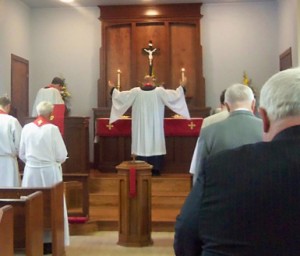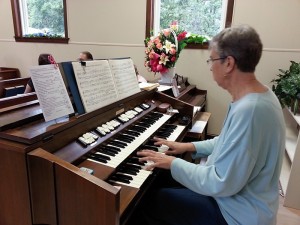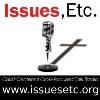
Pastor Galler leads prayers in the congregation’s 60th Anniversary Vespers Service. Over the course of a liturgical service, Lutheran pastors represent both God to the congregation and the congregation before God.
At Pilgrim, the historic liturgy of the Christian Church and hymns provide the context for our worship of the Triune God by our receiving the forgiveness He offers in Word and Sacrament. As discussed in the following, our use of the historic liturgy and hymns is in keeping with God’s Word, continuous with that use of the Church of all times and places, still “contemporary” today, and appropriately distinct from the world.
People sometimes say that God does not prescribe a specific form of worship, and that statement is certainly true insofar as none of the worship books a church may use dropped from heaven intact or were as a whole inspired the same way we hold Scripture to be inspired. However, that inspired Scripture not only reports countless Divine prescriptions for worship but also provides the basis for if not the very words used in the historic liturgy and hymns. We say back to God what He has first said to us (the origins of the Greek and Latin words for “confess” entail the ideas of “saying the same thing” and “saying with”). God given Old Testament worship at the Tabernacle and then the Temple developed under God’s providence into the worship at the synagogues of the inter testamental period and the worship of the New Testament, initially in people’s homes and later, when Christianity was legal, in buildings set aside for that purpose.
Over time, the basic structure of the chief Christian church service is an identifiable constant, even as precise wordings (not to mention languages!) and sacred musical settings changed. At various points in time, such as the Reformation, liturgical revision removed errors’ accretions to the service, in order to let the truth of God’s law and Gospel come through. More recently, efforts have been made to make liturgy and hymns as common as possible across both different Christian denominations and different Lutheran bodies, which effort has its merits for identifying common ground between different religious groups. While the first Lutherans never insisted that worship be precisely the same in every place, they thought too much of the teaching and confessing benefits of the relatively uniform historic liturgy and hymns to have abused their Christian freedom by abandoning them wholesale. (Various religious traditions today that intentionally avoid the historic liturgy and hymns often unintentionally end up with their own identifiable service structure and song repertoire nevertheless; the parts missing from their services but found in the historic liturgy, not to mention the different content of their songs, say a great deal about their different theological emphases.)
Such movement away from historic liturgy and hymns is often done to make services “contemporary”, a word or concept that often goes undefined. The historic liturgy and hymns are modern and relate to the present time, especially in that they provide the proper context for us to receive the forgiveness of sins Jesus Christ won for us on the cross, which alone meets our only true need of every time and place. Pilgrim is not locked in some unchanging past, however. In its earliest days, the congregation used the Lutheran Church—Missouri Synod’s 1941 The Lutheran Hymnal, for some three decades used the Synod’s 1982 Lutheran Worship, and since the First Sunday in Advent 2013 is using the Synod’s 2006 Lutheran Service Book. (Admittedly, people do not always know the name of their hymnal, instead referring to it by its relative newness or its color, even though each of the different hymnals has itself often been available in different colors, although, TLH was usually red or blue, LW was almost always a lighter blue of multiple shades, and LSB is a sort of burgundy.) There is no perfect hymnal; each has its own weaknesses and strengths, though the basic structure of the chief service is still an identifiable constant in all of the Divine Service settings that LSB incorporates from TLH and LW and Hymnal Supplement ‘98. (Pilgrim rotates through LSB‘s first four settings on a four-year cycle.) Most people appreciate that the unchanging ordinaries of the historic liturgy provide structure and similarity from week to week, while its changing propers and hymns provide something different each week. (Familiar structure and expressions are especially important for those who are either too young to read or too old or otherwise unable to see to read.) Like its predecessors, LSB also includes numerous other settings for morning and evening worship, devotional and instructional materials, and a wide variety of hymns, both historic and modern.

Long-time Pilgrim organist Carolyn Holcombe helps conduct worship from the organ bench, leading the congregation in singing both the hymns and its responses in the liturgy.
In good Lutheran practice, the musical settings of the historic liturgy and hymns are intended to serve the texts they accompany, as God’s Word is always of first importance. The hymn texts sung in any given service are specially chosen to fit the theme of the day or season, though significant consideration is also given to the congregation’s familiarity with the accompanying music. Music for worship is never intended to conform to the secular world but to help keep the service experience distinct from the secular world. And, one can hardly blend secular music with sacred texts: style hardly ever changes without also impacting substance.
Some people even travel a distance to be able to worship at Pilgrim and so receive God’s forgiveness where the historic liturgy and hymns are still respected and used. We recognize that the historic liturgy and hymns can be unfamiliar to others, and we welcome the opportunity to help anyone come to appreciate and treasure them as we do. For more information about any aspect of our worship or to experience it for yourself, see the contact and schedule information on the right.

